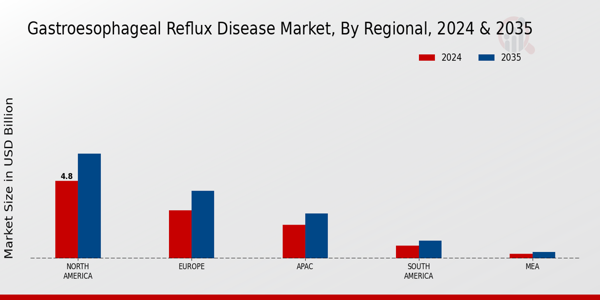Aging Population
The aging population is a significant factor influencing the Global Gastroesophageal Reflux Disease Market Industry. As individuals age, the prevalence of GERD tends to increase due to physiological changes and comorbidities associated with older age. This demographic shift is expected to drive demand for GERD treatments as older adults often experience more severe symptoms and complications. Consequently, healthcare providers are likely to focus on developing tailored treatment plans for this population. The market's growth trajectory is further supported by the increasing life expectancy, which may lead to a larger segment of the population requiring management for GERD.
Market Growth Projections
The Global Gastroesophageal Reflux Disease Market Industry is projected to experience substantial growth over the coming years. With an estimated market value of 11.0 USD Billion in 2024, it is anticipated to reach 15 USD Billion by 2035, reflecting a compound annual growth rate of 2.89% from 2025 to 2035. This growth is driven by various factors, including the rising prevalence of GERD, advancements in treatment options, and increased awareness among patients. The market dynamics suggest a robust expansion trajectory, indicating a promising future for stakeholders in the GERD management sector.
Rising Prevalence of GERD
The Global Gastroesophageal Reflux Disease Market Industry is experiencing growth due to the increasing prevalence of GERD worldwide. Factors such as dietary habits, obesity, and sedentary lifestyles contribute to this rise. In 2024, the market is projected to reach 11.0 USD Billion, reflecting a growing awareness and diagnosis of GERD. This trend is likely to continue as more individuals seek medical attention for symptoms associated with reflux. The increasing incidence of related complications, such as esophagitis and Barrett's esophagus, further emphasizes the need for effective treatment options, thereby driving market expansion.
Growing Awareness and Education
Increased awareness and education regarding GERD symptoms and treatment options are pivotal drivers in the Global Gastroesophageal Reflux Disease Market Industry. Public health campaigns and educational initiatives by healthcare organizations play a crucial role in informing patients about the condition. This heightened awareness leads to earlier diagnosis and treatment, which is essential for preventing complications. As more individuals recognize the importance of addressing GERD, the market is likely to see a steady increase in demand for therapeutic interventions, supporting a compound annual growth rate of 2.89% from 2025 to 2035.
Advancements in Treatment Options
Innovations in treatment modalities are propelling the Global Gastroesophageal Reflux Disease Market Industry forward. The introduction of novel pharmacological agents and minimally invasive surgical techniques offers patients more effective and safer options. For instance, the development of proton pump inhibitors and endoscopic procedures has transformed the management of GERD. These advancements not only improve patient outcomes but also enhance the overall quality of life for those affected. As the market evolves, the demand for these innovative treatments is expected to increase, contributing to the projected market growth to 15 USD Billion by 2035.
Regulatory Support for New Therapies
Regulatory bodies are increasingly supportive of the development and approval of new therapies for GERD, which is a key driver in the Global Gastroesophageal Reflux Disease Market Industry. Streamlined approval processes and incentives for innovation encourage pharmaceutical companies to invest in research and development. This regulatory environment fosters the introduction of new medications and treatment modalities that address unmet needs in GERD management. As a result, the market is likely to benefit from a continuous influx of novel therapies, enhancing treatment options available to patients and contributing to overall market growth.

























Leave a Comment